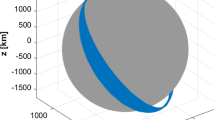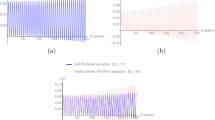Abstract
The analytic perturbation solutions to the motions of a planetary orbiter given in this paper are effective for 0e1, where e is the orbital eccentricity of the orbiter. In the solution, it is assumed that the rotation of the central body is slow, and its astronomical background is clear. Examples for such planets in the solar system are Venus and Mercury. The perturbation solution is tested numerically on two Venusian orbiters with eccentric orbits, PVO and Magellan, and found to be effective.
Similar content being viewed by others
References
Kaula, W. M., Theory of Satellite Geodesy, Chapter 3, Waltham: Blaisdell Publ. Co., 1966.
Giacaglia, G. E. 0., A note on the inclination functions of satellite theory, Celest. Mech., 1976, 13: 503.
Liu, L., Orbital Dynamics for Artificial Earth’s Satellite (in Chinese), Chapter 5, Beijing: Higher Education Press, 1992.
Brouwer, D., Clemence, G. M., Methods of Celestial Mechanics, Chapter 11, New York-London: Academic Press, 1961.
Fehlberg, E., NASA TR R-287, 1968.
Nerem, R., Bills, McNamee, J., A higher resolution gravity model for Venus, 1GVM-1, Geophys. Res. Lett., 1993, 20(7): 599.
Author information
Authors and Affiliations
Rights and permissions
About this article
Cite this article
Liu, L., Shum, C.K. Analytic perturbation solutions to the Venusian orbiter due to the nonspherical gravitational potential. Sci. China Ser. A-Math. 43, 552–560 (2000). https://doi.org/10.1007/BF02897148
Received:
Issue Date:
DOI: https://doi.org/10.1007/BF02897148




